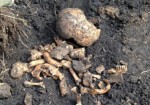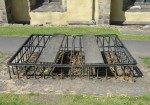 In September of 2012, a workmen installing a deck in the back yard of a six-bedroom terraced house in Grove Street, Edinburgh, unearthed some bones. At first they assumed they were animal remains and kept going, but soon they came across human skulls and teeth and so alerted the police. Forensic specialists tented the “crime scene” and examined the bones on site for 24 hours. Once they determined the bones were likely to be at least a century old, the police called in the Edinburgh City Council.
In September of 2012, a workmen installing a deck in the back yard of a six-bedroom terraced house in Grove Street, Edinburgh, unearthed some bones. At first they assumed they were animal remains and kept going, but soon they came across human skulls and teeth and so alerted the police. Forensic specialists tented the “crime scene” and examined the bones on site for 24 hours. Once they determined the bones were likely to be at least a century old, the police called in the Edinburgh City Council.
Council archaeologists led by Museum of Edinburgh curator John Lawson excavated the garden looking for more bones and clues to why they had been buried there and when. A total of 60 individual bones were found, all disarticulated. Four adult jawbones were identified and fragments of small jawbone that may have been a child’s. There was no cemetery in the area and the terraced row houses were built on the property in 1822. The bodies may have been buried there before the land was developed. At the time, there was some speculation that they could have been hastily buried victims of the Great Edinburgh Plague of 1645, although the few remaining bones don’t align with the piles of bodies found in other Edinburgh plague pits.
Now radiocarbon dating results of the bones have finally been announced and the bones are much later than the Great Plague. They date to the early 19th century,
Maureen Kilpatrick, a lead archeologist at Guard, said: “We found four right-sided jaws and we also had enough bones likely to be a young person.
“There were quite a few little holes in them which were to cater for wires, which leads us to believe they were used for anatomical purposes.
“We found they were likely to date back to the early 1800s, and although there were no medical professionals living in the house, we believe they had friends who were.”
So the bones weren’t necessarily buried before the townhouses were constructed. There may have been some overlap, which could implicate the house itself in the dirty illicit trade in corpses for anatomical study. There’s about a ten-year window during which the Grove Street townhouse may have been surreptitiously using stolen bones for demonstration purposes because the grave-robbing trade ended abruptly when the Anatomy Act of 1832 for the first time made sufficient numbers of cadavers available to medical schools.
Before that, only executed criminals were condemned to dissection after death, and even those didn’t always make it to the lab because people — friends, family, comrades — would take down the bodies before the anatomists could get to them to give them a decent burial. The Anatomy Act widened the pool of bodies considerably. The bodies of the destitute who died in a prison, hospital or workhouse and whose remains were unclaimed would be given to medical schools.
 The new provisions for cadaver supply ended the anatomists’ reliance on grave-robbers, known as resurrection men or resurrectionists for their dedication to raising the dead from their tombs. It was a hugely lucrative trade. The 18th century saw an explosion in private anatomy and surgery schools run out of teachers’ homes, and Edinburgh, home of the University of Edinburgh Medical School (est. 1726) and The Royal Infirmary (est. 1729) was a capital of medical training. There were never enough bodies in Edinburgh, and the population of the city was well aware they were all at risk of being torn from their graves and subjected to irreligious indignities. The cemeteries in Scotland are still dotted with mortsafes — padlocked cages embedded over fresh graves — and guard towers where friends, family and hired security would watch over the cemetery until they could be sure their charges were too decayed to be of use.
The new provisions for cadaver supply ended the anatomists’ reliance on grave-robbers, known as resurrection men or resurrectionists for their dedication to raising the dead from their tombs. It was a hugely lucrative trade. The 18th century saw an explosion in private anatomy and surgery schools run out of teachers’ homes, and Edinburgh, home of the University of Edinburgh Medical School (est. 1726) and The Royal Infirmary (est. 1729) was a capital of medical training. There were never enough bodies in Edinburgh, and the population of the city was well aware they were all at risk of being torn from their graves and subjected to irreligious indignities. The cemeteries in Scotland are still dotted with mortsafes — padlocked cages embedded over fresh graves — and guard towers where friends, family and hired security would watch over the cemetery until they could be sure their charges were too decayed to be of use.
 With the supply meager and the job gruesome, resurrectionists could charge top dollar for their macabre products. Sometimes, they even went so far as to ensure the desired cadaver was found in good condition by killing its possessor. The most notorious resurrectionists, William Burke and William Hare, were not just grave-robbers but highly accomplished serial killers who murdered at least 16 people to sell their bodies. They got their victims drunk and smothered or suffocated them, then sold their bodies to eminent surgeon Dr. Robert Knox who ran an anatomy lecture series out of his home.
With the supply meager and the job gruesome, resurrectionists could charge top dollar for their macabre products. Sometimes, they even went so far as to ensure the desired cadaver was found in good condition by killing its possessor. The most notorious resurrectionists, William Burke and William Hare, were not just grave-robbers but highly accomplished serial killers who murdered at least 16 people to sell their bodies. They got their victims drunk and smothered or suffocated them, then sold their bodies to eminent surgeon Dr. Robert Knox who ran an anatomy lecture series out of his home.
Burke and Hare were caught in November of 1828. Hare testified against Burke in return for release. Burke was hanged on January 28th, 1829, and dissected publicly the next day. Hare was hounded out of Dumfries a couple of months later and went off the grid completely to be seen only in random Elvis-like sightings.
The sensation of their crimes, trial and execution played an important role in the passage of the Anatomy Act. Burke and Hare’s doings underscored the desperate shortage of cadavers for study and how highly respected professionals were made complicit in the resurrectionists’ ugly trade.
For a fascinating and relatively quick read on the resurrection men and the dawn of the Anatomy Act, see The Diary of a Resurrectionist which is an actual diary, a log of bodies — the diarist calls them “things” — unearthed, whether they were adult, child or fetus, whether they had gone “bad” already, how much they sold for, which gang members got too drunk to work or claim their proper shares when it was time to settle accounts.